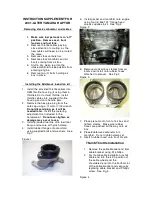
Safety Precautions
19
•
Components that could be damaged by
welding sparks should be removed from the
unit.
•
Use normal welding procedures, but keep the
ground return electrode as close to the area
being welded as practical. This will reduce the
likelihood of stray welding currents passing
through any electronic circuits.
First Aid
First Aid, Refrigerant
In the event of frostbite, protect the frozen area
from further injury, warm the area rapidly and
maintain respiration.
EYES :
For contact with liquid, immediately flush
eyes with large amounts of water. CALL A
PHYSICIAN.
SKIN:
Flush area with large amounts of warm
water. Do not apply heat. Remove contaminated
clothing and shoes. Wrap burns with dry, sterile,
bulky dressing to protect from infection. CALL A
PHYSICIAN. Wash contaminated clothing before
reuse.
INHALATION:
Move victim to fresh air and use
CPR (cardio pulmonary resuscitation) or
mouth-to-mouth resuscitation to restore breathing,
if necessary. Stay with victim until emergency
personnel arrive.
First Aid, Refrigerant Oil
EYES :
Immediately flush with water for at least
15 minutes. CALL A PHYSICIAN. Wash skin
with soap and water.
INGESTION:
Do not induce vomiting.
Immediately contact local poison control center or
physician.
First Aid, Engine Coolant
EYES :
Immediately flush with water for at least
15 minutes. CALL A PHYSICIAN. Wash skin
with soap and water.
INGESTION:
Do not induce vomiting.
Immediately contact local poison control center or
physician.
First Aid, Electrical Shock
Take IMMEDIATE action after a person has
received an electrical shock. Get quick medical
assistance, if possible.
The source of the shock must be quickly stopped,
by either shutting off the power or removing the
victim. If the power cannot be shut off, the wire
should be cut with an non-conductive tool, such as
a wood-handle axe or thickly insulated cable
cutters. Rescuers should wear insulated gloves
and safety glasses, and avoid looking at wires
being cut. The ensuing flash can cause burns and
blindness.
If the victim must be removed from a live circuit,
pull the victim away with a non-conductive
material. Use wood, rope, a belt or coat to pull or
push the victim away from the current. DO NOT
TOUCH the victim. You will receive a shock from
current flowing through the victim’s body. After
separating the victim from power source,
immediately check for signs of a pulse and
respiration. If no pulse is present, start CPR
(cardio pulmonary resuscitation). If a pulse is
present, respiration might be restored by using
mouth-to-mouth resuscitation. Call for emergency
medical assistance.
Summary of Contents for UT-1200
Page 10: ...Table of Contents 10...
Page 20: ...Safety Precautions 20...
Page 76: ...Operating Instructions for Premium HMI Control Panel 76...
Page 88: ...Electrical Maintenance 88...
Page 98: ...Engine Maintenance 98 Figure 167 Fuel Components...
Page 142: ...Refrigeration Service Procedures 142...
Page 148: ...Clutch Maintenance 148...
Page 150: ...Structural Maintenance 150...
Page 162: ...Wiring and Schematic Diagrams Index 162...
Page 163: ...163 Schematic Diagram Page 1 of 2...
Page 164: ...164 Schematic Diagram Page 2 of 2...
Page 165: ...165 Wiring Diagram Page 1 of 5...
Page 166: ...166 Wiring Diagram Page 2 of 5...
Page 167: ...167 Wiring Diagram Page 3 of 5...
Page 168: ...168 Wiring Diagram Page 4 of 5...
Page 169: ...169 Wiring Diagram Page 5 of 5...
















































